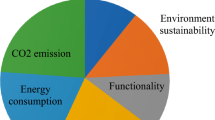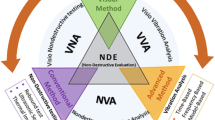Abstract
As an efficient tool in handling uncertain issues, Dempster-Shafer evidence theory has been increasingly used in structural health monitoring and damage detection. In applications, however, Dempster-Shafer evidence theory sometimes leads to counter-intuitive results. In this study, a new fusion algorithm of evidence theory is put forward to address various counter-intuitive problems and manage the reliability difference of the evidence. The proposed algorithm comprises the following aspects: (1) Dempster’s combination rule is generalized by introducing the concept of evidence ullage. The new rule allows classical Dempster’s rule and can resolve counter-intuitive problems cause by evidence conflict and evidence compatibility; (2) a reliability assessing method based on a priori and posterior knowledge is proposed. Compared with conventional reliability assessment, the proposed method can reflect the actual evidence reliabilities and can efficiently reduce decision risk. Numerical examples confirm the validity and utility of the proposed algorithm. In addition, an experimental investigation on a spatial truss structure is carried out to illustrate the identified ability of the proposed approach. The results indicate that the fusion algorithm has no strict request on the accuracy and consistency of evidence sources and can efficiently enhance diagnostic accuracy.
Similar content being viewed by others
References
Au TT and Zhang FL (2016), “Fundamental Two-Stage Formulation for Bayesian System Identification, Part I: General Theory,” Mechanical Systems and Signal Processing, 66-67: 31–42.
Bao TT, Xie XL and Wei ZK (2017), “Novel Approach for Measuring the Conflict Between Evidence,” Control Theory& Applications, 1:41–48. (in Chinese)
Bao YQ, Li H, An YH and Ou JP (2012), “Dempster-Shafer Evidence Theory Approach to Structural Damage Detection,” Structural Health Monitoring, 11(1):13–26.
Beena P and Ganguli R (2011), “Structural Damage Detection Using Fuzzy Cognitive Maps and Hebbian Learning,” Applied Soft Computing, 11(1): 1014–1020.
Brincker R, Zhang L and Andersen P (2001), “Modal Identification of Output-Only Systems Using Frequency Domain Decomposition,” Smart Materials & Structures, 10(3): 441–445.
Chandrashekhar M and Ganguli R (2009), “Damage Assessment of Structures with Uncertainty by Using Mode-Shape Curvatures and Fuzzy Logic,” Journal of Sound and Vibration, 325(3-5): 939–957.
Chandrashekhar M and Ganguli R (2016), “Damage Assessment of Composite Plate Structures with Material and Measurement Uncertainty,” Mechanical Systems and Signal Processing, 75: 75–93.
Contursi T, Messina A and Williams EJ (1998), “A Multiple-Damage Location Assurance Criterion Based on Natural Frequency Changes,” Journal of Vibration and Control, 4(5): 619–633.
Dempster AP (1967), “Upper and Lower Probabilities Induced by a Multi-Valued Mapping,” Annuals of Mathematical Statistics, 38(4): 325–339.
Deng Y (2015), “Generalized Evidence Theory,” Applied Intelligence, 43: 530–543.
Destercke S and Burger T (2013), “Toward an Axiomatic Definition of Conflict Between Belief Functions,” IEEE Transactions on Cybernetics, 43(2): 585–596.
Dominik I, Iwaniec M and Lech L (2013), “Low Frequency Damage Analysis of Electric Pylon Model by Fuzzy Logic Application,” Journal of Low Frequency Noise Vibration and Active Control, 32(3): 239–251.
Dubois D and Prade H (1998), “Representation and Combination of Uncertainty with Belief Functions and Possibility Measures,” Computational Intelligent, 4(3): 244–264.
Farrar CR, Doebling SW and Nix DA (2001), “Vibration-Based Structural Damage Identification,” Philosophical Transactions of the Royal Society of London Series A-Mathematical Physical and Engineering Sciences, 359 (1778): 131–149.
Farrar CR and Worden K (2007), “An Introduction to Structural Health Monitoring,” Philosophical Transactions of the Royal Society A-Mathematical Physical and Engineering Sciences, 365(1851): 303–315.
Haenni R (2002), “Are Alternatives to Dempster’S Rule of Combination Real Alternatives? Comments on “About the Belief Function Combination and the Conflict Management Problem”—Lefevre et al,” Information Fusion, 3(3): 237–239.
Hillis JM, Ernst MO, Banks MS and Landy MS (2002), “Combining Sensory Information: Mandatory Fusion Within, but Not Between, Senses,” Science, 298(5598): 1627–1630.
Humar J, Bagchi A and Xu HP (2006), “Performance of Vibration-Based Techniques for the Identification of Structural Damage,” Structural Health Monitoring, 5(3): 215–241.
Jousselme AL, Liu C and Grenier D (2006), “Measuring Ambiguity in the Evidence Theory,” IEEE Transactions on Systems Man &Cybernetics Part A Systems & Humans, 36(5): 890–903.
Langone R, Reynders E, Mehrkanoon S and Suykens JAK (2017), “Automated Structural Health Monitoring Based on Adaptive Kernel Spectral Clustering,” Mechanical Systems and Signal Processing, 90: 64–78.
Lefevre E and Colot OP (2002), “Belief Functions Combination and Conflict Management,” Information Fusion, 3(2): 149–162.
Liu T, Li AQ, Ding YL, Zhao DL and Li ZJ (2011), “Multi-Source Information Fusion Applied to Structural Damage Diagnosis,” Structure and Infrastructure Engineering, 7(5): 353–367.
Lu LL, Song HW, Yuan W and Huang CG (2017), “Baseline-Free Damage Identification of Metallic Sandwich Panels with Truss Core Based on Vibration Characteristics,” Structural Health Monitoring, 16(1): 24–38.
Nakamura EF, Loureiro AAF and Frery AC (2007), “Information Fusion for Wireless Sensor Networks: Methods, Models, and Classifications,” ACM Computing Surveys, 39(3): Article 9/1–55.
Ni YC, Lu XL and Lu WS (2017), “Operational Modal Analysis of a High-Rise Multi-Function Building with Dampers by a Bayesian Approach,” Mechanical Systems and Signal Processing, 86: 286–307.
Reynders E, Wursten G and De Roeck G (2014), “Output-Only Structural Health Monitoring in Changing Environmental Conditions by Means of Nonlinear System Identification,” Structural Health Monitoring, 13(1): 82–93.
Schubert J (2011), “Conflict Management in Dempster-Shafer Theory Using the Degree Of Falsity,” International Journal of Approximate Reasoning, 52(3): 449–460.
Shafer GA (1976), Mathematical Theory of Evidence, Princeton: Princeton University Press.
Shi ZY, Law SS and Zhang LM (2000), “Optimum Sensor Placement for Structural Damage Detection,” Journal of Engineering Mechanics, 126(11): 1173–1179.
Shi ZY, Law SS and Zhang LM (1988), “Structural Damage Localization From Modal Strain Energy Change,” Journal of Sound and Vibration, 218(5): 825–844.
Smets P (2005), “Decision Making In the TBM: the Necessity of the Pignistic Transformation,” International Journal of Approxmate Reasoning, 38(2): 133–147.
Vaez SRH and Arefzade T (2017), “Vibration-Based Damage Detection of Concrete Gravity Dam Monolith via Wavelet Transform,” Journal of Vibroengineering, 292(1-2): 179–202.
Vanik, MW, Beck JL and Au SK (2000), “Bayesian Probabilistic Approach to Structural Health Monitoring,” Journal of Engineering Mechanics, 126(7): 738–745.
Xu LY, Zhang BF and Xu WM (1997), “Evidence Ullage Analysis in D-S Theory and Development,” Journal of Software, 15(1): 69–75. (in Chinese)
Yager RR (1987), “On the Dempster-Shafer Framework and New Combination Rule,” Information Sciences, 41(2): 93–137.
Zadeh LA (1984), “Review of Shafer’s Mathematical Theory of Evidence,” Information Sciences, 5(3): 81–83.
Zhang FL, Xiong HB, Shi WX and Ou X (2016), “Structural Health Monitoring of Shanghai Tower During Different Stages Using a Bayesian Approach,” Structural Control & Health Monitoring, 23(11): 1366–1384.
Zhang FL and Au SK (2016), “Fundamental Two-Stage Formulation for Bayesian System Identification, Part II: Application to Ambient Vibration Data,” Mechanical Systems and Signal Processing, 66-67: 43–61.
Zhang JC, Zhou SP, Li Y, Su YS and Zhang PG (2015), “Improved D-S Evidence Theory for Pipeline Damage Identification,” Journal of Vibroengineering, 17(7): 3527–3537.
Zhu SY, Chen ZW, Cai QL, Lei Y and Chen B (2014), “Locate Damage in Long-Span Bridges Based on Stress Influence Lines and Information Fusion Technique,” Advances in Structural Engineering, 17(8): 1089–1102.
Acknowledgment
This research is financially supported by the National Natural Science Foundation of China (No. 51708446). The authors gratefully acknowledge this support.
Author information
Authors and Affiliations
Corresponding author
Rights and permissions
About this article
Cite this article
Ding, Y., Yao, X., Wang, S. et al. Structural damage assessment using improved Dempster-Shafer data fusion algorithm. Earthq. Eng. Eng. Vib. 18, 395–408 (2019). https://doi.org/10.1007/s11803-019-0511-z
Received:
Accepted:
Published:
Issue Date:
DOI: https://doi.org/10.1007/s11803-019-0511-z




